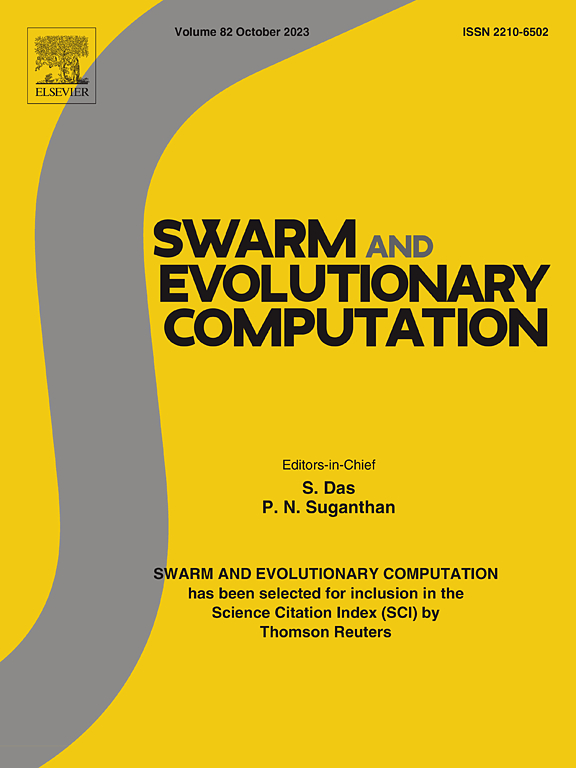考虑不确定性的可再生综合电力系统排放负荷经济调度的群智能搜救方法
IF 8.2
1区 计算机科学
Q1 COMPUTER SCIENCE, ARTIFICIAL INTELLIGENCE
引用次数: 0
摘要
在电力系统领域,经济排放负荷调度(EELD)问题是最重要的双目标优化问题之一,具有高复杂性和非线性。本研究提出了一种混合了 PSO 和 SAR 的新型元启发式优化方法,简称为 Swarm Intelligent Search and Rescue method (SISAR)。它利用粒子群优化算法的特点,加强了原 SAR 算法的全局搜索能力。SISAR 利用 PSO 基于速度的位置更新概念来提高整体收敛性,从而克服了 SAR 陷入局部最小值的缺点。SISAR 方法最初在 10 台 2000 MW 和 6 台 IEEE30 总线标准测试系统上进行了评估。评估结果与 SAR、PSO、GWO、WOA、GA、DE 和 MFO 等先进算法进行了比较,以证明其优越性。在无可再生能源的系统中建立拟议算法后,该算法进一步应用于由 6 个火电机组、1 个风电机组和 1 个太阳能机组组成的可再生能源集成电力系统。在此,采用两阶段不确定性处理方法来处理可再生能源带来的不确定性,从而获得更准确、更可行的 EELD 解决方案。在求解 EELD 时,通过研究不同可再生能源渗透水平对成本和排放的影响,确定了不确定性处理方法的稳健性。与 SAR(下一个有竞争力的方法)相比,所提出的 SISAR 算法在对所有来源的可再生能源集成系统执行 EELD 时,成本降低了 1.67%,排放量降低了 2.56%。本文章由计算机程序翻译,如有差异,请以英文原文为准。
Swarm Intelligent Search and Rescue method for economic emission load dispatch of renewable integrated power system considering uncertainty
In the realm of power systems, Economic Emission Load Dispatch (EELD) problem is one of the most important bi-objective optimisation problem, associated with high complexity and non-linearities. This research proposes a novel metaheuristic optimization approach hybridizing the PSO and SAR and abbreviated as Swarm Intelligent Search and Rescue method (SISAR). It utilizes the features of Particle Swarm Optimization algorithm to strengthen the global searching capability of original SAR algorithm. SISAR overcomes the drawback of SAR of getting trapped into local minima by utilizing velocity-based position update concept of PSO to improve the overall convergence. SISAR approach is initially evaluated on 10-unit, 2000 MW and 6-unit, IEEE30 bus standard test systems. Results are compared with advanced algorithms such as SAR, PSO, GWO, WOA, GA, DE and MFO in order to prove its superiority. Subsequent to the establishment of the proposed algorithm on system without renewable sources, it is further applied to a RE integrated power system comprising of six thermal units, 1 wind and 1 solar unit. Here, uncertainty due to RESs is dealt using a 2-stage uncertainty handling approach to obtain more accurate and feasible EELD solution. Robustness of the uncertainty handling approach is established by investigating the impact of different penetration levels of RE sources on cost and emission while solving EELD. A reduction of 1.67 % in cost and 2.56 % in emission have been achieved by proposed SISAR algorithm as compared to SAR (next competitive method) while performing EELD on RE integrated system with all sources.
求助全文
通过发布文献求助,成功后即可免费获取论文全文。
去求助
来源期刊

Swarm and Evolutionary Computation
COMPUTER SCIENCE, ARTIFICIAL INTELLIGENCEC-COMPUTER SCIENCE, THEORY & METHODS
CiteScore
16.00
自引率
12.00%
发文量
169
期刊介绍:
Swarm and Evolutionary Computation is a pioneering peer-reviewed journal focused on the latest research and advancements in nature-inspired intelligent computation using swarm and evolutionary algorithms. It covers theoretical, experimental, and practical aspects of these paradigms and their hybrids, promoting interdisciplinary research. The journal prioritizes the publication of high-quality, original articles that push the boundaries of evolutionary computation and swarm intelligence. Additionally, it welcomes survey papers on current topics and novel applications. Topics of interest include but are not limited to: Genetic Algorithms, and Genetic Programming, Evolution Strategies, and Evolutionary Programming, Differential Evolution, Artificial Immune Systems, Particle Swarms, Ant Colony, Bacterial Foraging, Artificial Bees, Fireflies Algorithm, Harmony Search, Artificial Life, Digital Organisms, Estimation of Distribution Algorithms, Stochastic Diffusion Search, Quantum Computing, Nano Computing, Membrane Computing, Human-centric Computing, Hybridization of Algorithms, Memetic Computing, Autonomic Computing, Self-organizing systems, Combinatorial, Discrete, Binary, Constrained, Multi-objective, Multi-modal, Dynamic, and Large-scale Optimization.
 求助内容:
求助内容: 应助结果提醒方式:
应助结果提醒方式:


